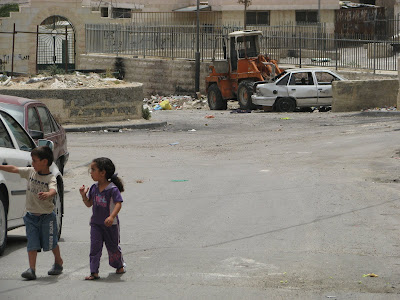 It's dramatically ancient too. The western part of Silwan has been inhabited since Neolithic times. It is here that the residential heart of the city stood from the second millennium BC to Hellenist times. When the Ommayads arrived in the 7th century, they found the hills inhabited with cave dwellers. A thousand years later, during the 19th century, Yemenite Jews came up from the desert and lived in the same caves.
It's dramatically ancient too. The western part of Silwan has been inhabited since Neolithic times. It is here that the residential heart of the city stood from the second millennium BC to Hellenist times. When the Ommayads arrived in the 7th century, they found the hills inhabited with cave dwellers. A thousand years later, during the 19th century, Yemenite Jews came up from the desert and lived in the same caves. The days of caves are over. Silwan today is about houses. Since conquering East Jerusalem in 1967, Israel has been incredibly stingy about giving building licenses to the Arab population.
The days of caves are over. Silwan today is about houses. Since conquering East Jerusalem in 1967, Israel has been incredibly stingy about giving building licenses to the Arab population. According to the Betzelem human-rights organization, 46,978 housing units have been built over the years on open land in East Jerusalem (designated as "municipal" since the occupation). All were built for the Jewish population. Not a single unit was built by or for the Arabs, who make up 33% of the city's population. Consequently, most Arab construction is deemed "illegal", and is designated for demolition.
The arab population grows naturally without anywhere to expend. the houses of Silwan are adorned with endless artificial add-ons, not all of which are fully sturdy. Silwan today is a dramatic mess, completely neglected by the authorities who would prefer to see it vanish.
 Since the eighties, Israeli governments have been working to get houses here demolished. One excuse for the demolitions are the unavoidable illegal constructions, another is the need to expose archaeological remains "from the days of King David." The dead King David, whether real or mythical, counts for much more than do 45,000 living residents of the neighborhood.
Since the eighties, Israeli governments have been working to get houses here demolished. One excuse for the demolitions are the unavoidable illegal constructions, another is the need to expose archaeological remains "from the days of King David." The dead King David, whether real or mythical, counts for much more than do 45,000 living residents of the neighborhood. Did I say neighborhood? We call Silwan a "village" as we refer to any Arab community. "Tamra" in the Galilee is a village, despite being twice the size of the "city" of Katzrin, a Jewish-Israeli community on the Golan heights. If Silwan were a village, its troubles could be considered smallish, but they aren't. They are dramatic.
Most dramatic of all is the problem of the settlements. The ElAd organization is using donations money to Judaise the neighborhood. I'm Jewish, I think any neighborhood in the world should be open to Jews, but I also read the Mishna. In the tome of Avot, Rabbi Yochanan Ben Zakai asks his deciples what would be a true righteous quality in a person. Rabi Yossei replies: "A good neighbor".
If you go as an Israeli to live in Silwan, in an absentee property from which the tennents were kicked out by force, you're not there to be a good neighbor. Silwan attracts right-wing activists who don't believe in the right of Palestinians to live where they were born. Thanks to the 50 families living there today, life in the neighborhood is highly controlled by the military.
Indeed, thanks to them, to the humanist minded ElAd organization and to the generous municipality of Jerusalem, distrust is abundant. I've never taken a walk anywhere where my camera evoked so much suspicion. Most were convinced that I am working for the house demolition authorities, but I came to shoot Silwan's beautifully painted walls, welcoming the Haj pilgrims upon return
 and its Esheresque staircases
and its Esheresque staircases and its abundant style.
and its abundant style. I didn't at all intend to write an angry post, but it's enough to walk around with open eyes and anger appears: raw anger, frustrating anger, anger that is as intense as the topography and as grey as the concrete, anger as dramatic as this place is.
I didn't at all intend to write an angry post, but it's enough to walk around with open eyes and anger appears: raw anger, frustrating anger, anger that is as intense as the topography and as grey as the concrete, anger as dramatic as this place is.

No comments:
Post a Comment